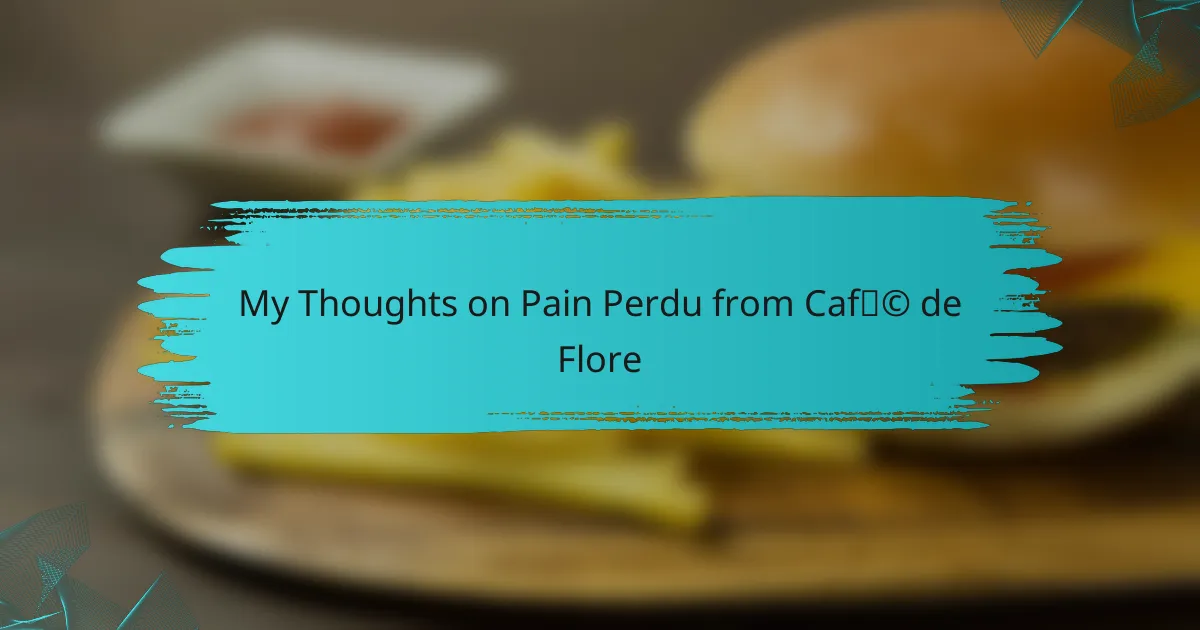Key takeaways
- French cafés are cultural hubs offering a charming ambiance where people connect over coffee and food, fostering a sense of community.
- Café culture in France dates back to the 17th century, evolving as gathering places for intellectuals and artists, particularly during the 19th century.
- Classic dishes like pain perdu and croque monsieur showcase the culinary heritage of France, often evoking nostalgia and cherished memories.
- Café de Flore, a historic café, embodies the café experience, combining delightful food with a rich cultural atmosphere, inviting visitors to savor both meals and memories.
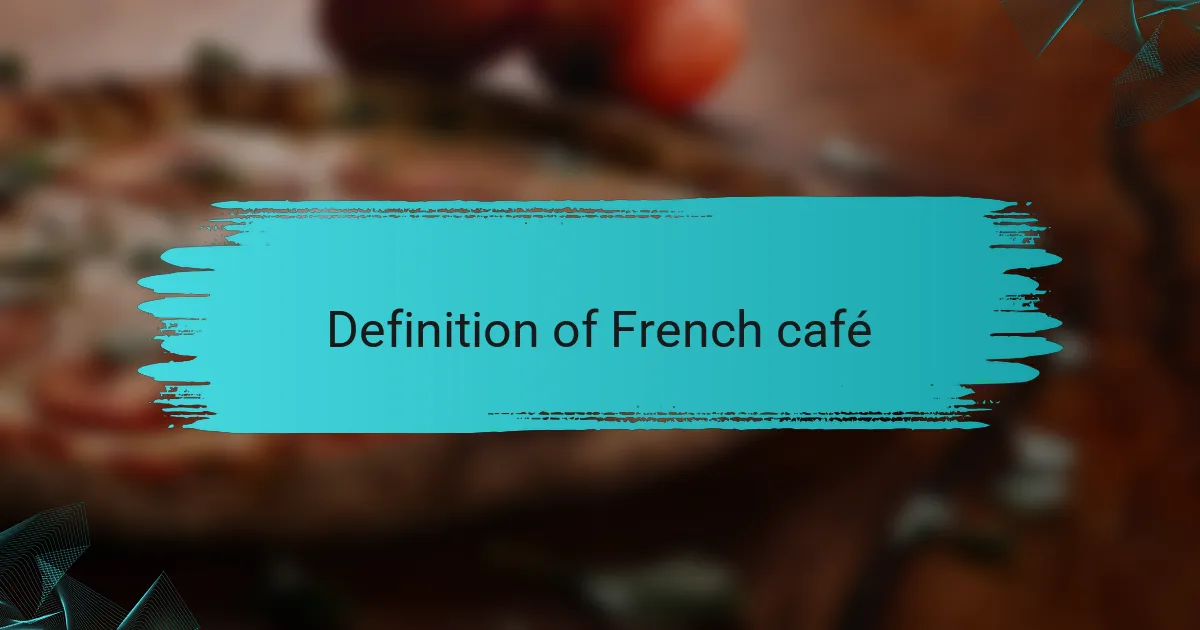
Definition of French Café
A French café is more than just a place to grab a cup of coffee; it embodies a unique cultural experience. These establishments are often characterized by their charming ambiance, where people gather to chat, work, or simply enjoy a moment of leisure. From the traditional wooden tables to the aroma of freshly baked pastries, each café has its own personality that reflects the local culture and social life.
What I cherish most about a French café is the sense of community it fosters. I remember sitting at Café de Flore, savoring a delicious pain perdu while watching the world go by. The café buzzes with conversation, laughter, and the clinking of cups—it’s a beautiful blend of the mundane and the extraordinary.
The allure of French cafés lies in their ability to transport you to a different time and place. They invite you to slow down, enjoy the simple pleasures, and connect with those around you.
| Feature | Description |
|---|---|
| Ambiance | Charming and culturally rich, often encouraging social interaction. |
| Menu | Offers a variety of beverages and pastries, including traditional items like pain perdu. |
| Location | Often situated in vibrant neighborhoods, perfect for people-watching. |
| Community | A gathering place for locals and visitors to connect and engage. |
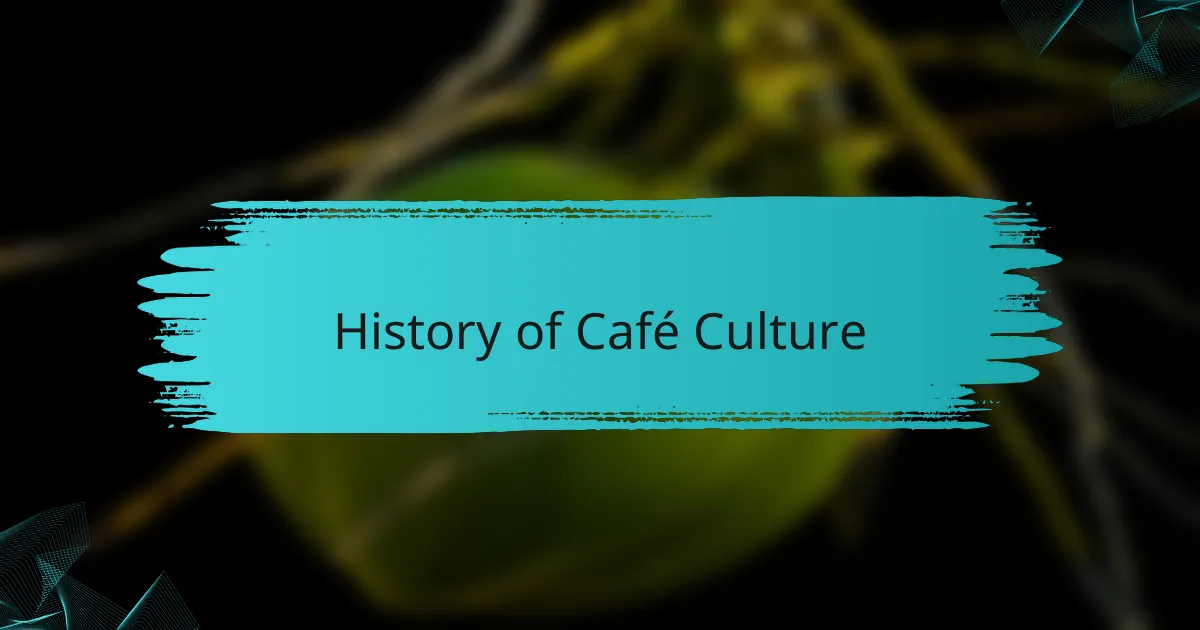
History of Café Culture
Café culture in France has a rich history that dates back to the 17th century when the first cafés began to pop up in Paris. These vibrant spaces were not merely places for coffee; they became cultural hubs where people gathered to exchange ideas, discuss politics, and appreciate art. I remember stepping into a café and feeling like I was part of history, surrounded by the chatter of creative minds.
The 19th century saw an explosion of cafés that catered to intellectuals, writers, and artists. Famous figures like Jean-Paul Sartre and Simone de Beauvoir frequented cafés, making them synonymous with existentialist thought. I often find myself daydreaming about those bustling scenes, imagining the strokes of conversation and the aroma of fresh pastries wafting through the air.
Today, visiting a café like Café de Flore feels like stepping into a time capsule. You can almost hear the echoes of past debates as you savor classic French breakfast items like pain perdu, a delightful reminder of how food has always been an integral part of this café culture.
| Period | Key Features |
|---|---|
| 17th Century | Emergence of the first Parisian cafés |
| 19th Century | Gatherings of intellectuals and artists; existentialist discussions |
| Modern Day | Cafés as cultural hubs; blending tradition with contemporary life |
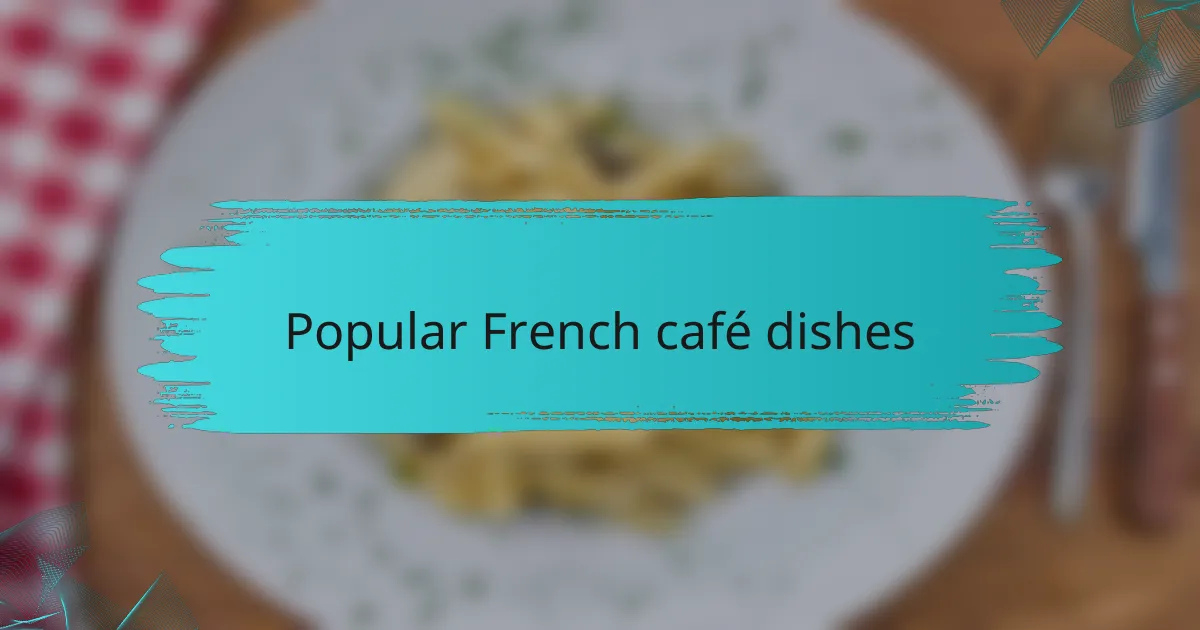
Popular French Café Dishes
French cafés are synonymous with a delightful array of dishes that showcase the country’s culinary flair. I often find myself indulging in classics like croissants and quiches as I sit—savoring each bite while inhaling the rich aroma of coffee. Every dish tells a story, reflecting the country’s deep-rooted gastronomic traditions.
One standout dish that resonates with many is the croque monsieur. It’s incredibly simple yet wonderfully satisfying, combining ham and cheese in a toasted sandwich that feels like a warm hug on a chilly day. I distinctly remember the first time I tasted it. The crispy bread contrasted with the gooey cheese left me craving more and wondering why I hadn’t tried it sooner.
Then there’s pain perdu, also known as French toast. Whenever I enjoy this dish, I can’t help but reminisce about lazy Sunday mornings spent at a café in Paris. The perfectly caramelized edges and the softness within make it a heavenly choice to pair with a cup of café au lait. Isn’t it fascinating how a single dish can evoke such vivid memories and emotions? It truly encapsulates the essence of what dining in a French café is all about.
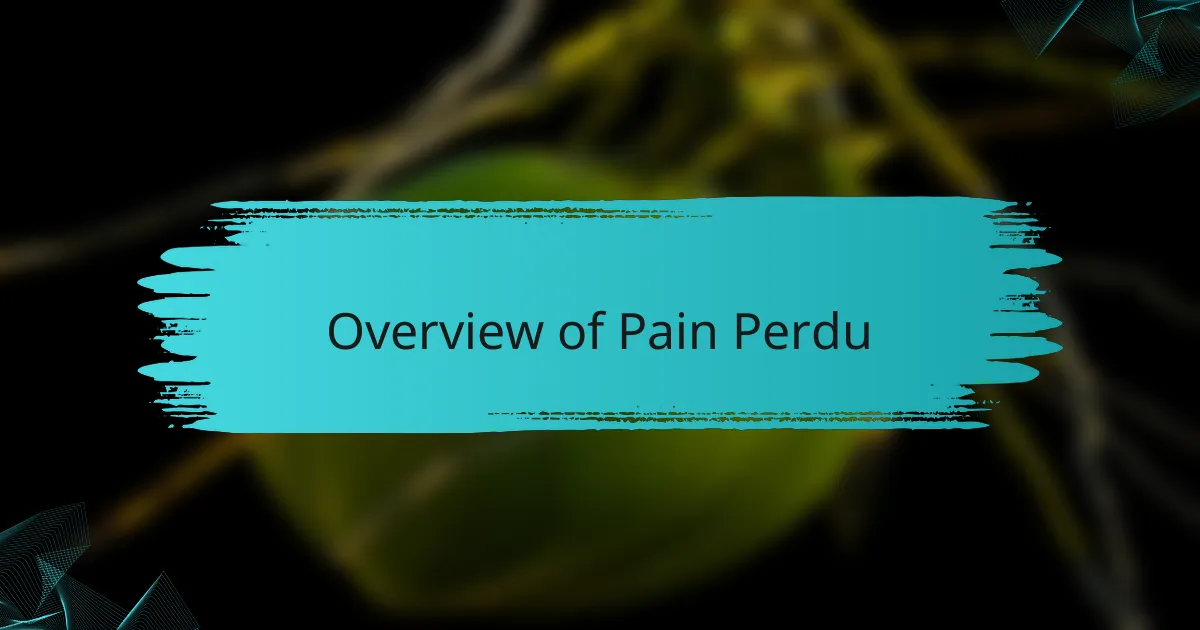
Overview of Pain Perdu
Pain Perdu, often referred to as French toast, is a beloved staple in many French cafés, including the iconic Café de Flore. It’s a delightful dish made by soaking slices of stale bread in a mixture of eggs and milk, then frying them to golden perfection. I remember my first visit to Café de Flore, where the warm aroma of freshly made Pain Perdu wrapped around me like a cozy hug. The first bite was nothing short of magical; the soft, custardy interior paired beautifully with a crisp exterior, leaving me with a feeling of comfort and indulgence.
One of the things I appreciate about Pain Perdu is its ability to evoke memories. Whether it’s the nostalgia of childhood breakfasts or the elegant ambiance of a Parisian café, this dish transcends time and brings people together. Café de Flore’s version is often served with a generous dusting of powdered sugar and a side of seasonal fruits, making it not just a meal but an experience.
Here’s a quick comparison to help illustrate some key aspects of Pain Perdu:
| Aspect | Details |
|---|---|
| Origin | French cuisine, traditionally made from stale bread |
| Preparation | Bread soaked in egg and milk mixture, then pan-fried |
| Serving Style | Usually served warm, often with powdered sugar and fruits |
| Emotional Connection | Evokes nostalgia, warmth and comfort |

Reasons to Try Pain Perdu
When you step into Café de Flore, trying their Pain Perdu is a must. This delightful take on French toast marries crispy edges with a fluffy center, and it’s drenched in a comforting hint of vanilla that warms the soul. I remember the first time I savored this treat; it felt like a nostalgic embrace, echoing the simple joys of childhood breakfasts.
Moreover, the presentation adds to the experience. Topped with fresh fruits, a drizzle of maple syrup, or a dusting of powdered sugar, it transforms a humble dish into an indulgence. Each bite brings a smile, reminding me of lazy Sunday mornings spent savoring life’s pleasures. It’s not just food; it’s a moment of happiness.
Here is a comparison table to highlight some reasons to try Pain Perdu:
| Reason | Description |
|---|---|
| Comfort | Its warm, comforting flavors evoke nostalgic memories. |
| Quality | Made with high-quality ingredients, it reflects traditional French culinary craftsmanship. |
| Presentation | A visually appealing dish that enhances your café experience. |
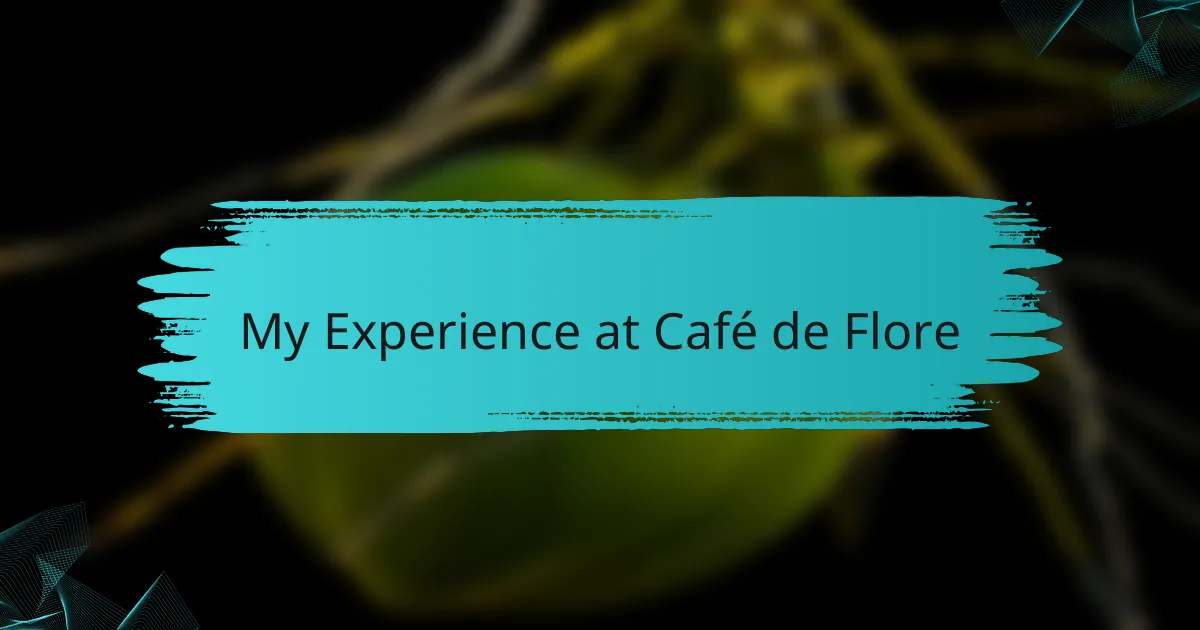
My Experience at Café de Flore
The moment I stepped into Café de Flore, I felt an immediate connection to its storied past. It’s the sort of place where you can almost hear faint echoes of intellectual debates mingling with the enticing aroma of fresh pastries. I found myself wrapped in the warmth of this vibrant environment, watching patrons find joy in their conversations while I delighted in my pain perdu.
With each bite, I was transported back to sun-drenched mornings of my youth. The crisp edges contrasted beautifully with the soft, custardy inside, reminding me of the comfort found in simple pleasures. That dish wasn’t just food; it was a delicious trip down memory lane—a symbol of both nostalgia and indulgence in the heart of Paris.
As I lingered over my plate, I couldn’t help but wonder how many others have shared similar moments at this café. It’s more than just a meal; it’s an experience that fosters connection and evokes emotions, making it a cherished ritual for anyone visiting Café de Flore.
